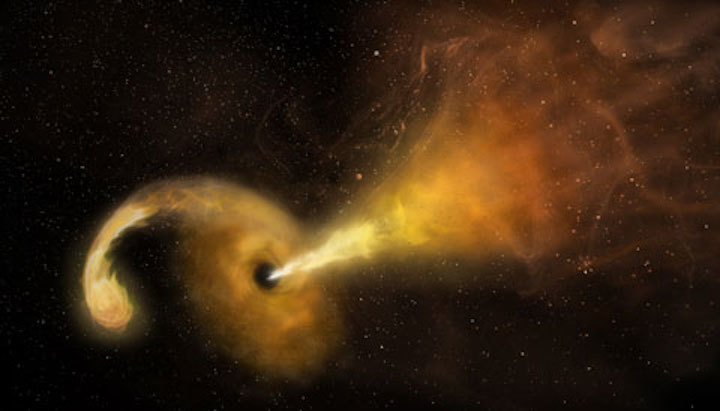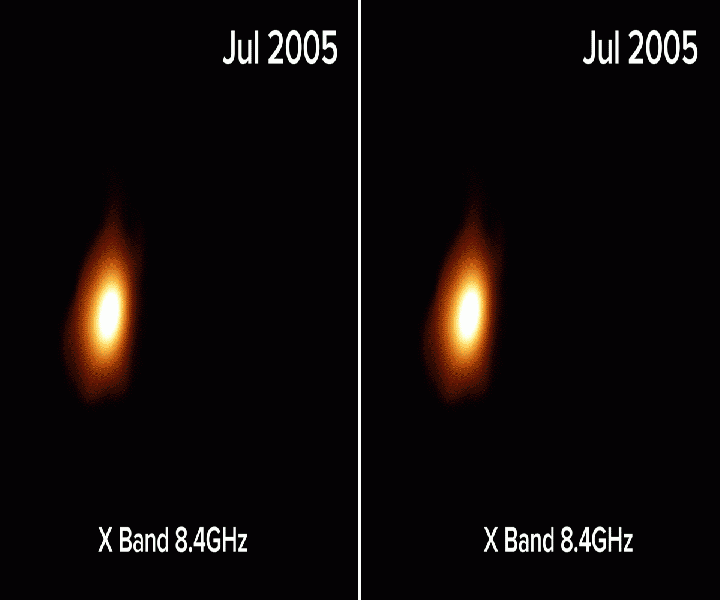15.06.2018

When stars zip too close to a supermassive black hole, they enter dangerous territory. How close “too close” is depends on the black hole, but for one that’s 10 million times the mass of the Sun, any star venturing closer than an astronomical unit is done for: The black hole will rip the star apart. Torn asunder, half the star goes whizzing away, while the other half forms a disk of hot gas around its destroyer. This gas heats and glows, appearing to our telescopes as a long-lasting flare.
Astronomers have detected a few dozen of these tidal disruption events (TDEs), usually in optical, ultraviolet, or X-ray wavelengths. Sometimes — maybe 10% of the time — the TDEs come with jets, beams of plasma powered by the newly formed gas disks. At least, that’s what observers infer based on the emission they see; light from the best-studied of the jet-shooting TDEs traveled some 4 billion years to reach us, much too far away for astronomers to see the jet itself.
Reporting June 14th in Science, Seppo Mattila (University of Turku, Finland) and colleagues say they’ve now done just that, successfully watching a shredded-star jet be born and grow over a decade.
The team stumbled across the event while looking for supernovae. The researchers were studying the galactic pileup Arp 299 (a.k.a. NGC 3690), two glorious spiral galaxies colliding some 140 million light-years away. The ongoing merger is driving gas into the galaxies’ central regions, building a brilliant accretion disk around the black hole in the western galaxy and triggering the creation of countless stars, many of which are massive enough to go supernova.

Over the course of a decade, astronomers watched the radio-emitting region in Arp 299's western core stretch out. Expansion indicates jet of particles moving outward. (Click to play.)
S. Mattila and M. Perez-Torres et al. / Bill Saxton (NRAO / AUI / NSF)
-
Mattila and colleagues spotted an infrared flare in January 2005 in the western galaxy’s nucleus, near the active black hole. By July, a compact radio source had joined it. As the team watched over the next decade with various ground- and space-based instruments, this radio source grew and stretched into a clumpy streak. Material in the jet at first moved at almost the speed of light, then quickly slowed down to a mere 22% of light speed as it ran into the surrounding gas and dust.
On its own, the existence of the jet doesn’t mean the flare-up is a TDE, cautions Suvi Gezari (University of Maryland). Active black holes are notoriously variable, flaring unexpectedly. But this event, called Arp 299-B AT1, has a big point in its favor: the jet’s angle. A big doughnut of dusty gas surrounds the black hole, and we see this torus from the side. Any jet fed by it would be oriented straight up-down from our perspective, like a pole stuck through an inner tube.
But Arp 299-B AT1’s jet points toward us, skewed only about 25° to 35° from our line of sight. That’s easily done with a disrupted star. A star can shoot toward the black hole at any angle, and the disk of gas created by its destruction can loop around the black hole and launch a jet unaligned with the original disk feeding the black hole.
“It’s a really nice demonstration that this was a star coming in, rather than some unusual flare,” says Andrew Levan (University of Warwick, UK), who like Gezari has spent years working on TDEs but wasn’t involved with the current study.
Arp 299-B AT1 is unusually unremarkable at optical and X-ray wavelengths. There appears to be a whole lot of gas and dust between the TDE and us, blocking and absorbing this radiation and eventually reemitting it in the infrared. Many galaxies’ cores, including our own, are replete with dust, and being able to spot one of these events behind so much dust could clear the way to finding them in galaxies where we’ve missed them before, Levan explains.
Based on the event’s intrinsic brightness and how much energy the team thinks went into heating the surrounding dust, the researchers estimate that it was the death of a star between 2 and 7 solar masses and unleashed a thousand times more radiation than a standard core-collapse supernova.
What a dramatic way to die.
Quelle: Sky&Telescope
